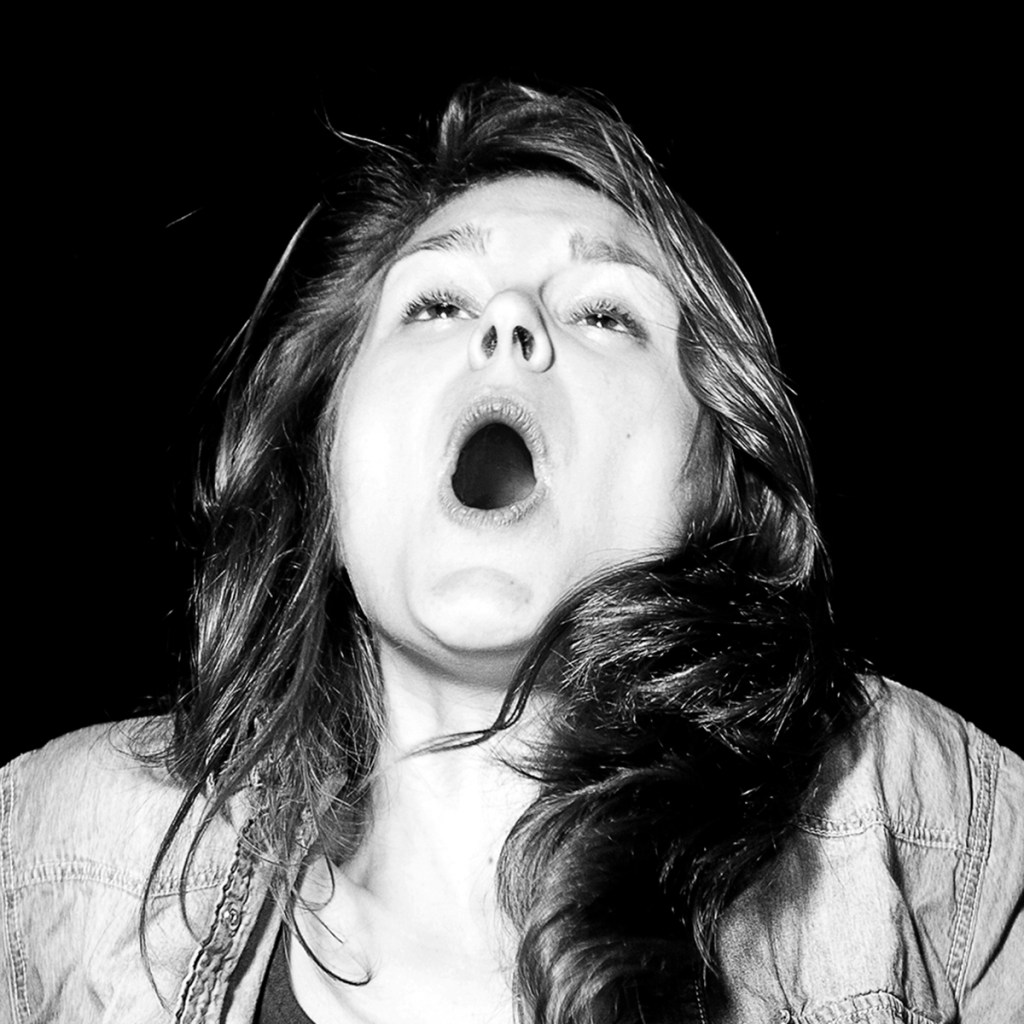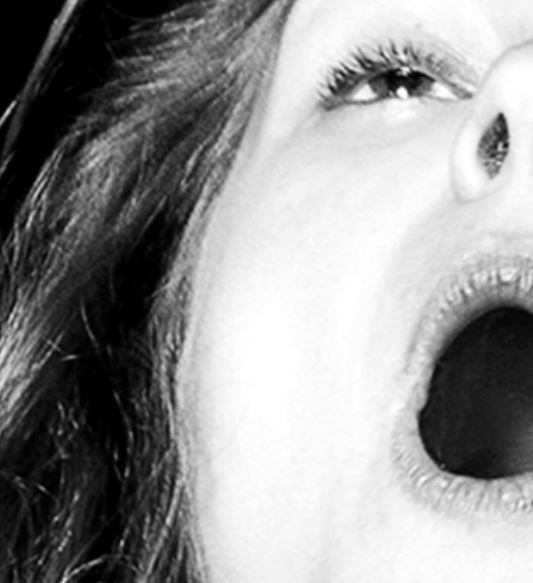Pauline Picot // 2013. Lyon, France. A young woman is sitting on a chair. She has long, well-groomed hair and is wearing a denim jacket. She knows what is about to happen. She agreed to participate. There is a disposable camera in front of her. She hesitates for a moment. Then she suddenly presses the button. An electric shock runs through her body as the photograph is taken. Her eyes are rolling; her body arches for a second. Her mouth opens wide, letting you stare right inside her.
1862. Paris, France. A young woman is sitting on a chair. She has long, dishevelled hair and is wearing a white dress, tight around the waist but loose about the shoulders. She probably knows what is about to happen. He must have asked her, as a formality, whether she was willing to participate, but as this is a ward and she has been committed to it, she no longer has any true freedom of choice. There is a daguerreotype in front of her. A man enters the frame. He is holding a sharp metallic tool. He does not hesitate and presses it to her forehead. An alternating current runs through her face as the photograph is being taken. The photograph is being taken. She holds the position and keeps her lips tightly pressed. The photograph is being taken. Her eyes are staring right inside yours.
The man who entered the frame is the French pioneer of neurology Guillaume Duchenne de Boulogne (1806-1875). He helped to identify several muscular diseases that were named after him and was the first clinician to ever perform a biopsy[1]. However, he is best known for his research on electrophysiology – the study of muscles through their biological response to electric stimulations – and especially for his experiences on “the expression of human passions” [2].
Duchenne sought to “discover the mechanisms and laws of human physiognomy” by “going backwards from the expressive muscle to the soul that set it in motion”[3]. In order to do so, he used faradism, i.e. the “application of alternating current […] with such precision as to only stimulate one muscular bundle at a time”. By doing so, he “replac[ed] the scalpel of the anatomist with electric current, using electricity as a physiological tool of investigation rather than a therapeutic tool (which was its common function at the beginning of the 19th century)”[4].
With provisional help from Félix Nadar’s stepbrother, the photographer Adrien Tournachon, Duchenne decided to keep records of his experiments by innovatively resorting to nascent photography, which results in a very unsettling and beautiful series presented in Mécanisme de la physionomie humaine ou analyse électro-physiologique de l’expression des passions [Mechanisms of human physiognomy: an electrophysiological analysis of the expression of human passions]. This series, which is often remembered as a vivid image of constraint and pain, can serve to exemplify the medical culture of the second half of the 19th century and its basis on authority, intimidation and subjugation[5]. And yet, Duchenne firmly insisted that he had taken precautions “not to sting nor cut the skin”[6] of his patients. But the sensation of unease that one feels while looking at the pictures – or rather while they look at you – lingers anyway.
Perhaps this sensation could be explained by the ambiguous approach of Duchenne’s project, as his work finds itself in a disturbing grey area between medical research and art. Indeed, Duchenne states that photography, as it inherently captures the ephemeral, will be of great help to fine arts, as it will reveal “the art of painting the expressive lines of the human face correctly” – his photographs thus serving as a kind of “syllabus for the physiognomy of movement”[7]. Furthermore, he takes several pictures of the woman described earlier, whom he associates to Lady Macbeth “when, after having made sure that Duncan and his guards […] are deeply asleep and after having given the ‘killing signal’ to Macbeth, waits for him to murder the king”[8] (fig.1). Last but not least, Duchenne’s series is undoubtedly a work of art of its own. This unprecedented hybridity, the bold assumption that human emotions could be falsified by new, modern methods and the consequent shift this implied in the perception of art as a whole might explain why Duchenne’s series wasn’t widely circulated in his time.


Mécanisme de la physionomie humaine ou analyse électro-physiologique de l’expression des passions,
Paris, Jules Renouard, 1862 (unpaginated). Public Domain.
But it is precisely this ambiguity that makes this series so mysterious and that accounts for it remaining as puzzling as it was when it was first produced. Nowadays, electricity no longer carries the powerful and almost threatening aura of unknown wonder it did in the 19th century, and it has been perfectly integrated to healthcare due to our familiarity with hospital equipment. But our yearning for the unnerving sensation it provokes will remain, according to the philosopher Tristan Garcia, a legacy of this period[9], in the form of a constant search for intensity in our lives.
This brings us back to the 2013 woman (fig.2). She is one of the many participants of Electrochoc, an interactive performance launched in 2004 by photographer Julie Guiches. This artist’s starting point is indeed a reverie about Duchenne’s work, but it includes all the parameters of 21st century ‘modernity’: the participants are aware that when they press the button on a modified disposable camera, they will simultaneously receive an electric shock and be photographed. This installation illustrates a shift in the perception of electricity, as people freely go for the shock and more often than not, they are immortalized with an expression of ecstasy on their faces. Furthermore, it seems to subtly underline a shift in our relation to medical authority, as people don’t need any exterior help or advice and are photographed alone.
This performance takes place at a time when photography has become a part of our daily lives and has lost the disturbing dimension of its early years. But Julies Guiches is not trying to revive this dimension or merely to pay a tribute to Duchenne’s experiments: she seems to be capturing a transition from healing to feeling; from a cautious attempt at mapping out the human body and its expressions to a reckless search for intensity.

Julie Guiches, 2013
Courtesy of Julie Guiches
[1] Kevin Nelson and Claude Genain (October 1989), “Duchenne de Boulogne and the Muscle Biopsy”, Journal of Child Neurology – JCN, 4, 315.
[2] Guillaume Duchenne de Boulogne, Mécanisme de la physionomie humaine ou analyse électro-physiologique de l’expression des passions, Paris, Jules Renouard, 1862. [Digitized by “Jubilothèque”, the online collection of the UMPC]
[3] Id., p.VI. My translation.
[4] Marta Braun, « Catherine Mathon (dir.), Duchenne de Boulogne (cat. exp.) », Paris, École Nationale Supérieure des Beaux-Arts, in Études photographiques 6|1999, http:// journals.openedition.org/etudesphotographiques/201, p.1. My translation.
[5] Nicole Edelman, Les Métamorphoses de l’hystérique. Du début du XIXe siècle à la Grande Guerre, Paris, La Découverte, 2003.
[6] Marta Braun, « Catherine Mathon (dir.), Duchenne de Boulogne (cat. exp.) », op. cit., p.1. My translation.
[7] Guillaume Duchenne de Boulogne, Mécanisme de la physionomie humaine ou analyse électro-physiologique de l’expression des passions, op. cit., p.VI.
[8] Id., p.170.
[9] Tristan Garcia, La Vie intense. Une obsession moderne, Paris, Autrement, 2016, p.30.
Proofreading by Aude Claret



